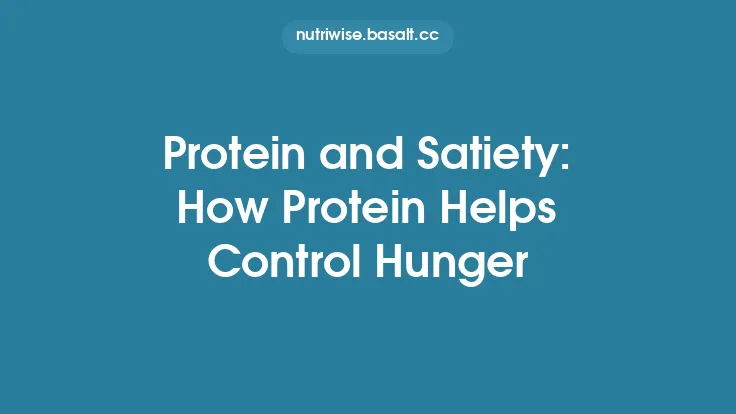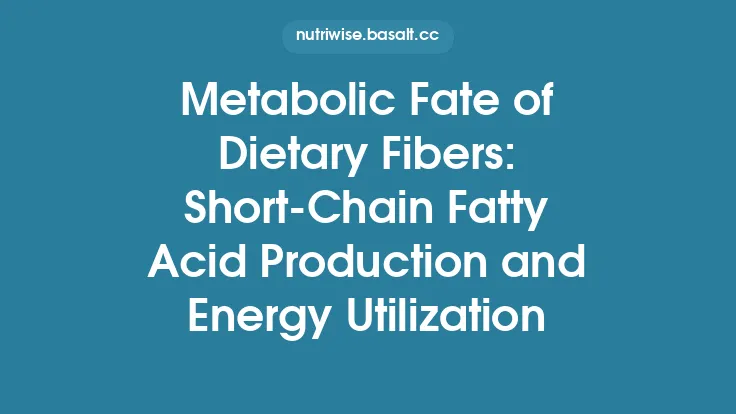Fiber is a unique class of carbohydrate that resists digestion in the upper gastrointestinal tract, arriving largely intact in the small intestine and colon. While its reputation is often built on supporting regularity and gut health, an equally important—and sometimes under‑appreciated—role is its ability to influence how full we feel after a meal. The sensation of fullness, or satiety, is a complex neuro‑hormonal response that integrates signals from the stomach, small intestine, and even the large intestine. Different fiber types interact with these signaling pathways in distinct ways, shaping the timing and magnitude of hunger suppression. Understanding these interactions helps nutrition professionals and food developers design meals and products that naturally curb overeating without relying on calorie‑dense additives.
The Physiological Pathways That Connect Fiber to Satiety
Satiety is orchestrated by a cascade of events that begin the moment food enters the mouth and continue well into the post‑absorptive phase. The primary mechanisms by which fiber modulates this cascade include:
- Mechanical Distension of the Stomach – Bulky fibers increase the volume of the gastric contents, stretching the stomach wall and activating stretch receptors that send satiety signals via the vagus nerve to the brainstem.
- Modulation of Gastric Emptying Rate – Certain fibers form gels or increase the viscosity of the chyme, slowing its passage into the duodenum. A slower gastric emptying rate prolongs the period during which the stomach remains distended, extending the satiety window.
- Nutrient Sensing in the Small Intestine – The presence of fiber can alter the rate at which macronutrients (especially carbohydrates and fats) are exposed to intestinal brush‑border enzymes, thereby influencing the release of enteroendocrine hormones such as glucagon‑like peptide‑1 (GLP‑1), peptide YY (PYY), and cholecystokinin (CCK). These hormones act on the hypothalamus to reduce appetite.
- Fermentation‑Derived Metabolites – In the colon, fermentable fibers are metabolized by resident microbes, producing short‑chain fatty acids (SCFAs) like acetate, propionate, and butyrate. SCFAs can bind to free fatty acid receptors (FFAR2/3) on enteroendocrine cells, stimulating additional release of PYY and GLP‑1, which feed back to the central nervous system to reinforce satiety.
- Blood Glucose Stabilization – By attenuating the post‑prandial glucose surge, fibers blunt the insulin response. Since rapid declines in blood glucose can trigger hunger, a more gradual glucose curve helps maintain a feeling of fullness.
These pathways are not mutually exclusive; rather, they act synergistically, and the relative contribution of each depends on the physicochemical properties of the fiber consumed.
Soluble vs. Insoluble Fibers: Distinct Satiety Profiles
The classic dichotomy of soluble and insoluble fiber provides a useful, though simplified, framework for predicting satiety effects.
| Property | Soluble Fiber | Insoluble Fiber |
|---|---|---|
| Water‑binding capacity | Forms viscous solutions or gels; high water‑holding | Swells but does not dissolve; adds bulk |
| Effect on gastric volume | Increases volume through gel formation; may delay gastric emptying | Increases volume through bulk; less impact on viscosity |
| Hormonal response | Stronger stimulation of GLP‑1, PYY due to delayed nutrient absorption | Modest hormonal impact; primary effect via mechanical distension |
| Fermentability | Generally more fermentable, producing SCFAs | Less fermentable; passes largely unchanged to colon |
| Typical food sources | Oats β‑glucan, psyllium husk, legumes, some fruits | Wheat bran, whole‑grain flours, nuts, seeds |
From a satiety standpoint, soluble fibers often produce a more pronounced and prolonged feeling of fullness because they simultaneously increase gastric volume, slow nutrient transit, and trigger hormone release. Insoluble fibers, while less potent in hormonal modulation, still contribute to satiety through bulk‑induced gastric distension and by adding “weight” to the meal without adding calories.
Viscous Fibers and Their Influence on Gastric Emptying
Viscosity is a key functional attribute of many soluble fibers. When mixed with water, viscous fibers create a thickened matrix that can:
- Delay the passage of chyme through the pylorus, extending the time the stomach remains full.
- Reduce the rate of glucose diffusion across the intestinal mucosa, flattening the post‑prandial glucose curve.
- Enhance the interaction of nutrients with enteroendocrine cells, amplifying hormone secretion.
Research consistently shows that fibers with higher viscosity (e.g., β‑glucan from oats, guar gum, and certain pectins) generate a stronger satiety response than low‑viscosity soluble fibers such as inulin. The magnitude of this effect is dose‑dependent; however, excessive viscosity can impair palatability and may cause gastrointestinal discomfort, so practical applications aim for a balance between functional efficacy and sensory acceptability.
Fermentable Fibers: Linking the Colon to Appetite Regulation
While the colon is traditionally viewed as the “end of the line” for digestion, it plays an active role in appetite control through microbial fermentation. Fermentable fibers—often classified as “prebiotic” in other contexts—are broken down by colonic bacteria into SCFAs. The relevance of this process to satiety includes:
- SCFA‑mediated hormone release – Propionate, in particular, has been shown to stimulate GLP‑1 and PYY more robustly than acetate or butyrate.
- Neural signaling – SCFAs can cross the colonic epithelium and influence vagal afferents, providing a direct gut‑brain communication route.
- Energy contribution – Although SCFAs supply a modest amount of calories (≈2 kcal g⁻¹), they do so in a form that does not provoke a rapid insulin response, thereby supporting a stable satiety signal.
Not all fermentable fibers are created equal. The degree of polymerization, branching pattern, and monosaccharide composition dictate how quickly and extensively a fiber is fermented, which in turn shapes the timing of SCFA production and its satiety impact. For example, short‑chain fructans are rapidly fermented, leading to early post‑prandial hormone spikes, whereas longer‑chain arabinoxylans ferment more slowly, extending the satiety effect into the later post‑absorptive phase.
Resistant Starch: A Hybrid Fiber with Unique Satiety Effects
Resistant starch (RS) occupies a niche between conventional starches and dietary fibers. It resists digestion in the small intestine and reaches the colon where it is partially fermented. Its satiety‑related properties stem from a combination of mechanisms:
- Physical Bulk – RS adds volume to the meal, contributing to gastric distension.
- Delayed Glucose Absorption – By limiting the immediate availability of glucose, RS blunts the early post‑prandial insulin surge, reducing the subsequent rebound hunger.
- SCFA Production – The fermentation of RS yields propionate and butyrate, which, as described above, stimulate satiety hormones.
Because RS is often incorporated into staple foods (e.g., cooled potatoes, legumes, whole‑grain breads), its contribution to satiety can be achieved without altering the overall dietary pattern.
Practical Strategies for Leveraging Fiber to Enhance Fullness
Translating the science of fiber‑induced satiety into everyday eating habits involves thoughtful food selection, preparation, and portioning. Below are evidence‑based recommendations that can be readily applied:
| Goal | Food Choices | Preparation Tips |
|---|---|---|
| Maximize gastric distension | Whole‑grain breads, brown rice, quinoa, legumes, nuts, seeds | Cook grains with a slightly higher water‑to‑grain ratio to retain moisture; add a handful of nuts or seeds to salads and soups. |
| Boost viscosity | Oats, barley, psyllium husk, chia seeds, flaxseed meal | Soak chia or flax seeds in water or milk for 10‑15 min to form a gel before adding to smoothies or yogurts. |
| Increase fermentable fiber | Chicory root (inulin), Jerusalem artichoke, dandelion greens, partially cooked beans | Incorporate small amounts (5‑10 g) of inulin or chicory root into baked goods or beverages; avoid over‑cooking beans to preserve fermentable fractions. |
| Add resistant starch | Cooked‑and‑cooled potatoes, rice, pasta; green bananas; high‑amylose corn | Prepare starchy foods ahead of time, cool them in the refrigerator, and reheat gently before serving to preserve RS content. |
| Combine fiber types for synergistic effect | Mixed grain bowls (e.g., quinoa + barley + lentils) topped with a chia‑flax seed dressing | Pair a viscous fiber (e.g., chia gel) with bulk‑adding insoluble fiber (e.g., roasted chickpeas) to achieve both immediate and prolonged satiety. |
Portion considerations: While higher fiber intakes generally promote satiety, abrupt increases can cause bloating or flatulence. A gradual escalation of 5 g per day, aiming for the recommended 25‑30 g/day for adults, allows the gut microbiota and motility patterns to adapt.
Timing: Consuming fiber‑rich foods at the start of a meal (e.g., a vegetable soup or a fiber‑enhanced starter) can pre‑load the stomach, setting the stage for reduced caloric intake during the main course.
Special Populations and Satiety‑Focused Fiber Use
| Population | Considerations | Fiber Recommendations |
|---|---|---|
| Older adults | Reduced gastric motility and altered taste perception | Emphasize soluble, gel‑forming fibers (e.g., oat β‑glucan) that are easy to chew and swallow; avoid excessive insoluble bulk that may cause constipation. |
| Athletes | High energy demands, need for rapid glycogen replenishment | Pair fermentable fibers with fast‑acting carbohydrates post‑exercise to moderate glucose spikes while still delivering satiety signals. |
| Individuals with IBS | Sensitivity to gas‑producing fibers | Favor low‑fermentable soluble fibers (e.g., psyllium) and limit high‑inulin foods; monitor tolerance and adjust portion sizes accordingly. |
| Weight‑management programs | Goal of sustained caloric deficit | Design meals that integrate a mix of viscous soluble fibers and resistant starch to prolong fullness without excessive caloric load. |
Emerging Research Directions
The field continues to evolve, with several promising avenues that may refine our understanding of fiber‑mediated satiety:
- Targeted fiber engineering – Advances in food processing enable the creation of fibers with customized molecular weight and branching, allowing precise control over viscosity and fermentability.
- Personalized microbiome‑satiety models – Integrating individual gut microbial profiles with dietary fiber intake could predict SCFA‑driven hormone responses, paving the way for tailored satiety‑enhancing diets.
- Neuroimaging studies – Functional MRI investigations are beginning to map how fiber‑induced hormonal changes translate into activity within the hypothalamus and reward centers, offering a mechanistic bridge between peripheral signals and central appetite regulation.
- Synergistic nutrient interactions – Research is exploring how protein, fat, and fiber co‑delivery influences satiety hormones, potentially informing the design of composite meals that maximize fullness while maintaining nutrient balance.
In sum, the relationship between dietary fiber and satiety is multifaceted, rooted in the physical properties of the fiber, its interaction with digestive physiology, and the downstream hormonal cascades that signal fullness to the brain. By selecting appropriate fiber types—viscous soluble fibers for rapid gastric distension and hormone release, bulk‑adding insoluble fibers for mechanical satiety, and fermentable fibers for colonic SCFA‑mediated signaling—consumers and food professionals can harness fiber’s natural appetite‑modulating power. This approach not only supports healthier eating patterns but also aligns with broader goals of weight management and metabolic wellness, all without relying on calorie‑dense additives or restrictive diets.




